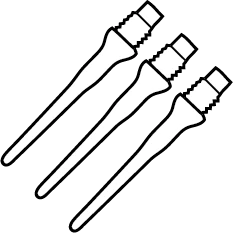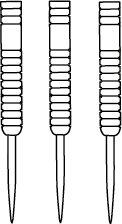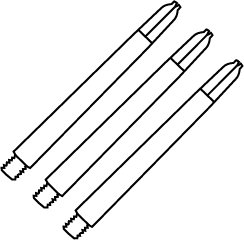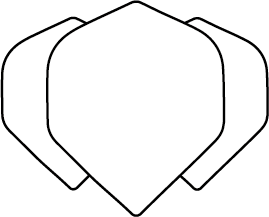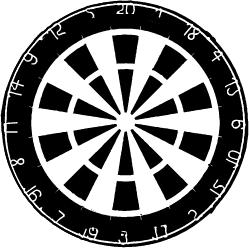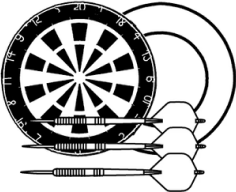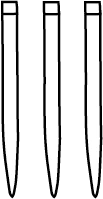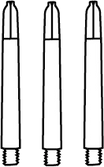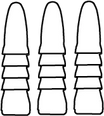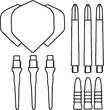Darts have been really flourishing in Germany for a few years now. The latest developments are causing ratings to skyrocket and many beginners to pick up darts .
But how exactly did darts come to us in Germany and since when has the sport existed as we know it today? We give you an overview of darts history !
The roots of darts history lie in England
To this day, it is not entirely clear how long arrows have been thrown at targets. The origins of darts history can be found towards the end of the 19th century . At that time, the players were not yet playing on high-quality dartboards made of sisal fibers.
Instead, they used simple wooden barrel bases that were converted into a disc hanging on the wall. The current division of the fields on the disc is therefore reminiscent of the structure of a wooden disc .
The structure of a dart board comes from a tree target
There are also some tips on dividing the segments on the dartboard. If you look at the structure of an ordinary tree disk, it becomes clear that the cracks in a dried tree disk often resemble the thin steel wires of a dartboard . This explains how the double and triple fields on the board came about.

Determination of the fields in 1896
The English carpenter Brian Gamlin defined the division of the value segments (also called fields) that are still valid today in 1896 and laid the foundations for the history of darts.
Back then, the Brit wanted to invent a game that was as varied and exciting as possible. To do this, he usually arranged two low segments next to the high fields. This arrangement is particularly useful today, as this is exactly how the big matches are decided in professional darts.

When did the first evidence of the emergence of darts appear?
Of course, there is still heated debate today about exactly how long darts have existed and where the history of darts begins. There is hardly any evidence left.
In some cases it is only possible to understand how exactly it came into being and what development followed. However, a newspaper from 1901 shows that an advertisement for dartboards suggests that darts already existed at the beginning of the 20th century .
The 1930s - a time when people still played with long wooden arrows
The perfected and lightweight darts made of brass or tungsten as we know them today were previously unheard of when it came to darts. Back in the basics of darts history, players still used arrows made of wood , a metal tip and a feather at the end .
The first brass arrows only came onto the market around the time of the Second World War . Suddenly darts became a mass phenomenon. In 1937, around 300,000 participants registered for the largest tournament of all time.
We're talking about the city championship in London at the time. Even the royals didn't miss this event, as the queen, Queen Mum, opened the games with a throw of her own. A milestone in darts history.
Court hearing becomes a breakthrough for darts
Despite the sometimes great response, darts continued to be considered a game of chance in England. With gambling banned in pubs, a pub owner in Leeds has been charged.
The defendant brought his darts and a dartboard to the court hearing and demonstrated to the judge on site that darts are not a game of chance.
After several games, the judge looked into it and was impressed to find that the arrows didn't land randomly on the board, but rather intentionally . As a result, the ban on darts in pubs was overturned, so that a dartboard could be found in almost every British pub shortly afterwards.
The way for the further success of darts history was paved.
The dart will also be perfected in the coming decades
Players repeatedly noticed that darts at the time were quite unwieldy . They also wore out quickly, meaning replacement parts had to be constantly used.
In order to increase sustainability and comfort for players, the dart also developed further. In the 1960s there was a breakthrough in darts history that continues to this day .
For the first time, tungsten (in English: tungsten) was discovered as a material for making darts . Due to the high density, it was possible to produce relatively narrow arrows that were still very heavy .
Even today it is impossible to imagine life without this revolution in the production of darts.

The level is getting higher – darts is expanding
The better arrows not only made the level of the players significantly higher . The sport of darts in general ventured out into the wide world for the first time in the 80s.
Great Britain was already in darts fever, now it was time to make the British sport known around the world. Especially in the early 1980s, sport in England boomed like never before. Even during TV broadcasts, tens of millions of viewers sat in front of their television sets.
Darts is also attracting attention for the first time in Germany
At that time, when darts was at its peak in England, there was hardly any sign of it in Germany. In some bars there were only the usual dart machines .
Steel darts were still almost unknown. But this changed at the beginning of the 21st century and the history of darts found its way into Germany. In 2004, the sports broadcaster “DSF” secured the rights to the PDC Darts World Cup.
Two days before Christmas Eve, the first game between Mark Holden and James Wade was broadcast live. Cult commentator Elmar Paulke is still raving about the first match on German television. In the years that followed, darts slowly but steadily emerged as a popular sport.
Viewer ratings in the millions
In recent years there has been a real hype surrounding darts and dart history. Steel darts in particular became more and more popular . More and more pubs were hanging a steel dartboard next to the usual dart machines.
In addition , the first organized leagues and teams were founded in German-speaking countries. Especially in the years since 2010, darts has seen ever higher ratings on television.
The rights to the World Cup are still held by Sport1 (formerly DSF). The World Cup final between Phil Taylor and Rob Cross on New Year's Day this year was seen by an average of more than 2 million viewers. A rate that would have been completely absurd in darts a few years ago.

There is no end in sight – the market continues to grow
There is still no end in sight to this positive development in darts history. The market for darts and boards continues to grow.
New leagues , new teams and new prospects are putting the sport in the spotlight. Many veteran players often complain that the sport is flooded with clueless newcomers.
Nevertheless, darts also has the potential to become a popular sport in Germany – as long as commercialization is kept within limits.
Ready to immerse yourself in the fascinating world of darts? Explore the secrets, tactics and compelling stories behind this exciting sport. Click in now and become a dart enthusiast!
- Darts on TV : pure thrill. Experience exciting tournaments and legends live. Find out now and see the professionals in action! Click in now! ✓
- The most impressive Darts records at a glance. Find out now and be amazed. Immerse yourself in the incredible world of top darts.
- Darts intro music - The musical start to the darts adventure & the key to the perfect atmosphere. Click here and get to know the sound of the professionals!





